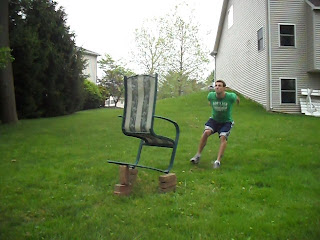Life demands power, the kind that doesn't necessarily corrupt.
Being strong (able to produce a lot of force) is good and all, but most physical activities both on and off an athletic field require the ability to generate a high amount of force quickly. When it comes to everything from dunking a basketball to dancing the night away, carrying groceries up stairs to shoveling tanbark to catching yourself from a stumble, the name of the game is power.
Power is the rate of doing work, or [Force X Velocity]. As you can see, being able to generate more force and being able to move faster both factor in to generating more power.
Plyos: a nervous system tune-up
Plyometric training is the best way to "teach" the brain how to coordinate the body and body segments to rapidly generate high forces.
What's considered "plyometric" is definitely relative to the individual, but movements like various sprints, step-ups, jumps, medicine ball tosses, and lunges are typical. In the back yard we push the limits of our horizontal and vertical leaping abilities with single- and two-leg exercises. In the clinic I spot older folks as they attempt to rapidly lunge and reach various directions, then recover to their starting position.
You really don't need much space or equipment for plyometrics. At home I have some gravity, ledges and graded surfaces for lower body training. And CHAIRS (see video)! We sporadically attempt higher level upper body plyometrics (which includes abs!). This usually involves "clap" push-ups, a medicine ball for various tosses, and a sledge hammer for hitting the big tire over at the neighbors.
If you're older and haven't trained in this manner, go ahead and test your body control with a simple set of lunges. If you're generally young and fit go ahead a try a few circuits of, say, 10 split jumps coupled with 5 to 10 clap push-ups*.
Briefly on resistance training
Resistance training is still essential for pretty much every training goal that you can think of. The right weight training (i.e. not isolation exercises seated on fancy chrome machines) also fine-tunes the nervous system, primarily for body control and stability. And of course, weight training is by far the only thing for body re-composition.
Getting jacked with bigger muscles is one thing, but resistance training is also critical for conditioning/weight loss purposes. I cannot understate how important it is in both the long- and short-term to "signal" the body to retain muscle and strength while you're in a calorie deficit. Lose the body fat and retain the magic-magic-magic.
I've said it before, but losing muscle when you "diet" sets you up for a frail and hungry cycle that usually ends with you either giving up or eating bland salads three meals per day and still not feeling very happy about the condition of those pesky "problem areas."
All we have is time
 |
| Not knowing the outcome. Pushing it. THAT's the moment. |
It's a matter of choices. This stuff is sort of a hobby that happens to be compatible with my profession. I live in a pretty modest home, drive a 98' Subaru to work, and have a pretty crappy tool collection. But I could care less. Today I wasn't worried about being in debt or hyper cleaning the house and I enjoyed plenty of time with my family and friends and I jumped over a freakin' 57-inch chair.
Do you know how far along those things will carry you into a productive, truly generous work week?
Training Plan
You do need to start slowly and give consistent effort and discipline over a long period of time. Training the entire body with "big" beneficial movements requires patience and some attention to detail. If you get bored or injured or stop prioritizing time for your physical well being after 6 weeks, well, now there's really no excuse.
You would have plenty of time and energy to do both strength training and plyos if you would step away from the seated leg extension/curl/abduction/adduction machines and cut back on all the random cardio and "split" body part routines.
Your shoulders are involved with almost all back, chest, tricep, and bicep exercises, as well as most squat and deadlift variations. So please don't tell me that you packed work clothes and toiletries and woke up at 5 a.m. and drove through traffic to do a "shoulders and biceps" workout. While this does qualify as disciplined effort, it's not exactly practical or effective.
Part two of this will include some specifics geared more toward athletes, including a sound training template.
- - - - - -
Split jumps - Begin with one foot out in front of you and one behind you. Jump high and land with the opposite foot in front/back. Upon landing, jump again, alternating which foot is in front/back. Start slow and pay attention to knee alignment.
Clapping push-ups - Like a push up, but do a quick turn around at the bottom and throw your upper body off the ground so you can clap your hands, land and begin the next push-up.
- - - - -
No comments:
Post a Comment